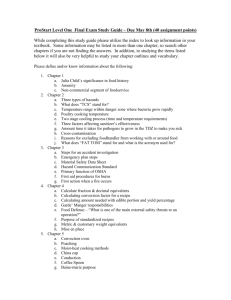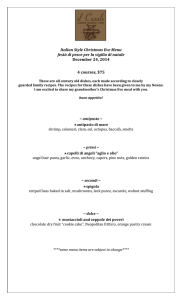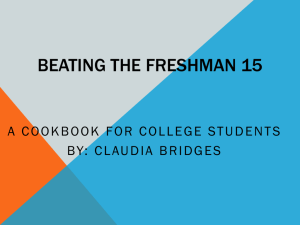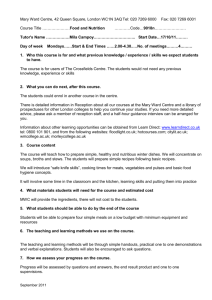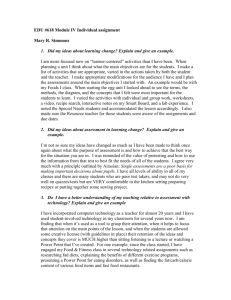Document 10841749
advertisement
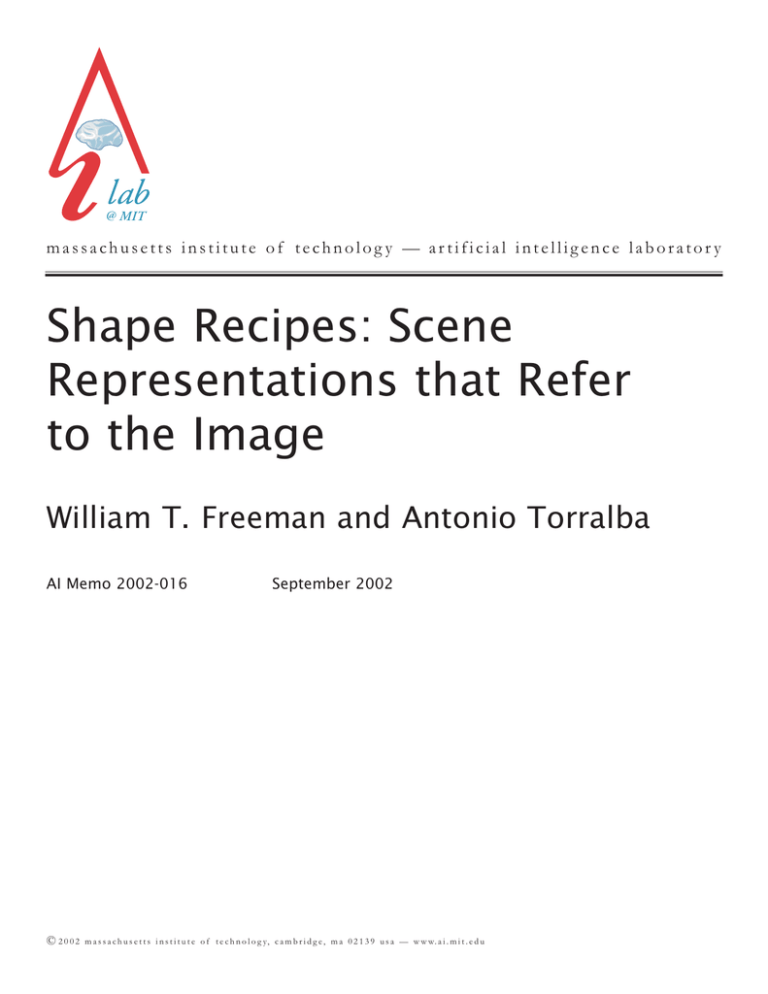
@ MIT
massachusetts institute of technolog y — artificial intelligence laborator y
Shape Recipes: Scene
Representations that Refer
to the Image
William T. Freeman and Antonio Torralba
AI Memo 2002-016
© 2002
September 2002
m a s s a c h u s e t t s i n s t i t u t e o f t e c h n o l o g y, c a m b r i d g e , m a 0 2 1 3 9 u s a — w w w. a i . m i t . e d u
Abstract
The goal of low-level vision is to estimate an underlying scene, given
an observed image. Real-world scenes (eg, albedos or shapes) can be
very complex, conventionally requiring high dimensional representations
which are hard to estimate and store. We propose a low-dimensional representation, called a scene recipe, that relies on the image itself to describe the complex scene configurations. Shape recipes are an example:
these are the regression coefficients that predict the bandpassed shape
from bandpassed image data. We describe the benefits of this representation, and show two uses illustrating their properties: (1) we improve
stereo shape estimates by learning shape recipes at low resolution and
applying them at full resolution; (2) Shape recipes implicitly contain
information about lighting and materials and we use them for material
segmentation1 .
This work was supported in part by a grant from NTT.
(a)
(b)
(c)
(c)
Fig. 1. 1-d example: The image (a) is rendered from the shape (b). The shape depends on the image
in a non-local way. Bandpass filtering both signals allows for a local shape recipe. The dotted line
(which agrees closely with true solid line) in (d) shows shape reconstruction from 9-parameter
linear regression (9-tap convolution) from bandpassed image, (c).
I. Introduction
We are interested in using machine learning methods to estimate from images various lowlevel scene properties, such as shape, material, albedo or motion. For such an estimation
task, the representation of the quantities to be estimated can be critical. Here we propose
and describe a new scene representation with appealing qualities for estimation. Typically,
these scene properties might be represented as a bitmap (eg [14]) or as a series expansion
in a basis set of surface deformations (eg [10]). To represent accurately the details of realworld shapes or textures requires either full-resolution images or very high order series
expansions. Having to infer high dimensional quantities makes the estimation intrinsically
difficult [3]. Strong priors are often needed [14], leading to arbitrary choices that can give
unrealistic shape reconstructions.
The approach we propose is to let the image itself bear as much of the representational
burden as possible. We assume that the image is always available and we describe the
underlying scene in reference to the image. The scene representation is a set of rules for
transforming from the local image information to the desired scene quantities. We call this
representation a scene recipe: a simple function for transforming local image data to local
scene data. The computer doesn’t have to represent every fold of an intricate shape; the
image does that for us, the computer just stores the rules for transforming from image to
shape. In this paper, we focus on reconstructing the shapes that created the observed image,
deriving shape recipes. The particular recipes we study here are regression coefficients for
transforming bandpassed image data into bandpassed shape data.
II. Shape Recipes
The shape representation consists in describing, for a particular image, the functional relationship between image and shape. These are not general rules, but rules specific to the
particular lighting and material conditions at hand. This functional relationship is what we
call shape recipes.
We require that the scene recipes be local, which simplifies the computations to obtain
shape from image data: the scene structure in a region should only depend on a local
neighborhood of the image. It is easy to show that, without taking special care, the shapeimage relationship is not local. Fig. 1 (a) shows the intensity profile of a 1-d image arising
from the shape profile shown in Fig. 1 (b) under particular rendering conditions (a Phong
model with 10% specularity). Note that the function to recover the shape from the image
cannot be local because the identical local images on the left and right sides of the surface
edge correspond to different shape heights.
In order to obtain locality in the shape-image relationship, we need to preprocess the
shape and image signals. When shape and image are represented in a bandpass pyramid,
within a subband, under generic rendering conditions [4], local shape changes lead to local
(a) image
(b) lowpass shape (center) and shape recipes
(c) shape recipes of (b)
applied to image (a), cropped
(d) laser scan
Fig. 2. Example illustrating shape recipes to represent shape of image (a). In low-frequency shape
range map (b, center), small carvings are not visible. Convolution kernels learned from lowresolution stereo range data and corresponding image subbands were applied to all spatial frequencies to yield shape (c), in general agreement with laser scan shape, (d).
image changes. Figures 1 (c) and (d) are bandpass filtered versions of (a) and (b), using a
second-derivative of a Gaussian filter. In this example, (d) relates to (c) by a simple shape
recipe: convolution with a 9-tap filter, learned by linear regression from rendered random
shape data. The solid line shows the true bandpassed shape, while the dotted line is the
linear regression estimate from Fig. 1 (c).
For 2-d images, we break the image and shape into subbands using a steerable pyramid
[13], an oriented multi-scale decomposition with non-aliased subbands (Fig. 4 (a) and (b)).
A shape subband can be related to an image intensity subband by a function
(1)
where
is a local function and
and are the th subbands of the steerable pyramid
representation of the shape and image, respectively. The simplest functional relationship
between
shape
and image
intensity is via a linear filter with a finite
size impulse response:
, where is convolution. The convolution
kernel
(specific
to each scale
and
orientation)
transforms
the
image
subband
into
the
shape
subband
!"#
%. The recipe
at each subband is %learned
by minimizing $ , regularizing as needed
to avoid overfitting.
contains information about the particular lighting conditions and
the surface material. More general functions can be built by using non-linear filters and
combining image information from different orientations and scales.
Figure 2 shows a shape recipe example. (a) is a photograph of a wood carving, at
320x160 pixels. (b) is the information, in addition to the image, that describes the shape:
a 20x20 image (top center) of a cropping of the low-frequency shape information, together
with the linear regression coefficients for each of the 4 subband orientations. (c) is the
reconstructed shape, applying the shape recipes to a cropping of the image. Note the fine
details of the carving shape are recovered, in agreement with (d) a Cyberware laser scan of
the wooden shape.
(a) Image
(b) Stereo shape
(c) Stereo shape (surface plot)
(d) Re-rendered
stereo shape
Fig. 3. Shape estimate from stereo. (a) is one image of the stereo pair; the stereo reconstruction is
depicted as (b) a range map and (c) a surface plot and (d) a re-rendering of the stereo shape. The
stereo image is noisy and misses fine details.
%
We learned the shape recipes by applying linear regression on the Cyberwaredata
for
the four orientations of the 3rd highest resolution subbands, and applying those
to the
top four resolution level subbands, scaling by two with resolution. (Shape discontinuities
require special handling using shape recipes and the steep edge is blurred out in the reconstruction; see Sect. V for more detail.) We used the same regression coefficients for the
4 pyramid levels up to 160x160. Thus, we can describe the 320x160 resolution shape of
image (a), 51,200 parameters, using a 40x20 low-resolution image plus 4 x 11 x 11 regression coefficients, or 1,284 parameters. Because of this dimensionality reduction, and the
possible stability over shape, scale, and time, we conjecture that shape recipes would make
good scene representations for estimation.
We conjecture that multiscale shape recipes have various desirable properties for estimation. First, they allow for a compact encoding of shape information, as all the complexity
of the shape is encoded in the image itself. The recipes only &specify
how to translate image
vary across scale and space
into shape. Secondly, regularities in how the shape recipes
provide a powerful mechanism for regularizing shape estimates. Instead of regularizing
shape estimates by assuming a prior of smoothness of the surface, we assume a slow spatial variation of the functional relationship between image and shape, which should make
estimating shape recipes easier. Third, shape recipes implicitly encode lighting and material information, which can be used for material-based segmentation. In the next two
sections we discuss the properties of smoothness across scale and space and we show potential applications in improving shape estimates from stereo and in image segmentation
based on material properties.
III. Scaling regularities of shape recipes
Fig. 3 shows one image of a stereo pair and the associated shape estimated from a stereo
algorithm1. The shape estimate is noisy in the high frequencies (see surface plot and rerendered shape), but we assume it is accurate in the low spatial frequencies.
We took our stereo photographs using a 3 Megapixel Olympus Camedia C-3040 camera, with a
Pentax stereo adapter. We calibrated the stereo images using the point matching algorithm of Zhang
[16], and rectified the stereo pair (so that epipoles are along scan lines) using the algorithm of [8],
(c) Shape recipes for each subband
(a) Image pyramid
(b) Shape pyramid
Fig. 4. Learning shape recipes at each subband. (a) and (b) are the steerable pyramid representations
of image and stereo shape. (c) shows the convolution kernels that best predict (b) from (a).
(a) image
(b) low-res shape and recipe
(d) re-rendered
recipes shape
(c) recipes shape (surface plot)
Fig. 5. Reconstruction from shape recipes. The shape is represented by the information contained
in the image (a), the low-res shape pyramid residual and the shape recipes (b) estimated at the
lowest resolution. The shape can be regenerated by applying the shape recipes (b) at the 4 highest
resolution scales. (d) shows the image re-rendered under different lighting conditions than (a).
The reconstruction is not noisy and shows more detail than the stereo shape, Fig. 3, including the
fine detail at the bottom left of the image (a).
Fig. 4 shows the steerable pyramid representations of the image (a) and shape (b) and the
learned shape recipes (c) for each subband (linear convolution kernels that give the shape
subband from the image subband). We exploit the slow variation of shape recipes over scale
and assume that the shape recipes are constant over the top four octaves of the pyramid 2.
Thus, from the shape recipes learned at low-resolution we can reconstruct a higher resolution shape estimate than the stereo output, by learning the rendering conditions then taking
advantage of shape details visible in the image but not exploited by the stereo algorithm.
Fig. 5 (a) and (b) show the image and the implicit shape representation: the pyramid’s lowresolution shape and the shape recipes used over the top four scales. Fig. 5 (c) and (d) show
explicitly the reconstructed shape implied by (a) and (b): note the high resolution details,
estimating
disparity with the Zitnick–Kanade stereo algorithm [17].
'
Except for a scale factor. We
scale the amplitude of the fixed recipe convolution kernels by 2 for
each octave, to account for a ( frequency fall-off in image spectral content.
(a) Shape
(b) Image
(c) Image-based
segmentation
(d) Recipe-based
segmentation
Fig. 6. Segmentation example. Shape (a), with a horizontal orientation discontinuity, is rendered
with two different shading models split vertically, (b). Based on image information alone, it is
difficult to find a good segmentation into 2 groups, (c). A segmentation into 2 different shape
recipes naturally falls along the vertical material boundary, (d).
including the fine structure visible in the bottom left corner of (d). Compare with the stereo
output in Fig. 3.
IV. Segmenting shape recipes
Segmenting an image into regions of uniform color or texture is often an approximation
to an underlying goal of segmenting the image into regions of uniform material. Shape
recipes, by describing how to transform from image to shape, implicitly encode both lighting and material properties. Across unchanging lighting conditions, segmenting by shape
recipes allows us to segment according to a material’s rendering properties, even across
changes of intensities or texture of the rendered image.
We expect shape recipes to vary smoothly over space except for abrupt boundaries
) at
changes in material or illumination. Within each subband, we can write the shape
as a
mixture of recipes:
* + -. , * +3
54 / 6 * /
/
021
(2)
)
where 7 specifies the number of recipes needed to explain the underlying shape . The
weights * / , which will be a function of location, will specify which recipe has to be used
within each region and, therefore, will provide a segmentation of the image.
To estimate the parameters of the mixture (shape recipes and weights), given known
shape and the associated image, we use the EM algorithm [15]. We encourage continuity
for the weights * / as neighboring pixels are likely to belong to the same material. We
use the mean field approximation to implement the spatial smoothness prior in the E step,
suggested in [15].
Figure 6 shows a segmentation example. (a) is a fractal shape, with diagonal left structure
across the top half, and diagonal right structure across the bottom half. Onto that shape,
we “painted” two different Phong shading renderings in the two vertical halves, shown
in (b) (the right half is shinier than the left). Thus, texture changes in each of the four
quadrants, but the only material transition is across the vertical centerline. An image-based
segmentation, which makes use of texture and intensity cues, among others, finds the four
quadrants when looking for 4 groups, but can’t segment well when forced to find 2 groups,
(c). (We used the normalized cuts segmentation software, available on-line [11].) The
shape recipes encode the relationship between image and shape when segmenting into 2
groups, and finds the vertical material boundary, (d).
(a) image
(e) shape recipe
(subband)
(b) image (subband)
(f) recipe&stereo
(subband)
(c) stereo depth
(g) recipe&stereo
(surface plot)
(d) stereo depth (subband)
(h) laser range
(subband)
(i) laser range
(surface plot)
Fig. 7. One way to handle occlusions with shape recipes. Image in full-res (a) and one steerable
pyramid subband (b); stereo depth, full-res (c) and subband (d). (e) shows subband of shape
reconstruction using learned shape recipe. Direct application of shape recipe across occlusion
boundary misses the shape discontinuity. Stereo algorithm catches that discontinuity, but misses
other shape details. Probabilistic combination of the two shape estimates (f, subband, g, surface),
assuming Laplacian shape statistics, captures the desirable details of both, comparing favorably
with laser scanner ground truth, (h, subband, i, surface, at slight misalignment from photos).
V. Occlusion boundaries
Not all image variations have a direct translation into shape. This is true for paint boundaries that do not correlate with shape variations and some occlusion boundaries that do not
generate an image boundary (e.g., a random dot stereogram).
With shape recipes, special cases need to be made for occluding edges, shape variations
that do not translate into image variations. For instance, in Fig. 7 (c) the occluding boundary in the shape only produces a smooth change in the image (Fig. 7 (a)). In that region of
the image, the shape recipes will produce an incorrect shape estimate, however, the stereo
algorithm will often success at finding those occlusion edges. On the other hand, stereo often fails to provide the shape of image regions with complex shape details. For the special
case of revising the stereo algorithm’s output using shape recipes, we propose a statistical
framework to combine both sources of information. We want to estimate the shape
that
maximizes the likelihood given the shape from stereo 8 and the image intensity :
* +=< * ;
* + 8:9 ; * :8 9 :8 9
(3)
(For notational simplicity,
we omit the spatial dependency from , 8 and .) As both stereo
8 and image
intensity
provide strong constraints for the possible underlying
+
shape
; , the
factor *
can be considered constant in the region of support of * 8:9 . * 8:9
is a
normalization factor. Eq. (3) can be simplified by considering that stereo and image intensity are conditionally independent. Furthermore, we also consider independence between
5
5
^
Zk
4
3
3
2
2
1
1
0
-2
-3
-3
-4
-4
-4 -3 -2 -1
0
1
2
3
4
fk(Ik)
-1
-2
-5
Sk = 2
0
Sk
fk(Ik) = -1
-1
^
Zk
4
5
-5
-4 -3 -2 -1
(a)
0
1
2
3
4
5
(b)
Least square estimate for the shape subband >2? given both stereo @A? and shape recipes
The graph (a) shows the final shape estimate as a function
of the shape estimated by
B
stereo. When the @A? is close to the value given by the recipes ?
CEDF?5G , then, the final shape >H?
does
vary with variations in the stereo estimation. The graph (b) shows >2? as a funcion of
B ?CEDF?not
G for a fix value of @A? . >H? is equal to B ?
CEDF?5G only when both recipes and stereo give similar
estimations.
Fig.B 8.
?CEDF?G .
the pixels in the image and across subbands:
8
* 8:9 JI I * 8 * 4K
(4)
,
and refer to the outputs of the subband . Although this is an oversimplification
it simplifies the analysis and provides good results.
The functions * 8 and *
will depend on the noise models for the depth
from stereo and for the shape recipes. For the shape estimate from stereo we assume a
gaussian distribution for the noise. Therefore, at each subband and spatial location we
have:
* 8 % *ML +N 8 %POQ:[R Z%S\HT5Q# 1 U
T%R V=W=X%YV
W=$5] L
(5)
In the case
#of^the
;shape
recipes, a gaussian noise model is not adequate. The distribution
of the error
will depend on image noise, but more importantly, on all shape and
image variations that are not related with each other. Fig. 7 illustrates this point: the image
data (Fig. 7 (b)) does not preserve the boundary that
&;exists
in the shape (Fig. 7(h)). When
trying to estimate shape using the shape recipe
, it fails to capture the
)Nboundary
_
;
although it captures correctly other texture variations (Fig. 7 (e)). Therefore,
will describe the distribution of occluding edges that do not produce image variations and
paint edges that do not translate into shape variations.
`N_
;Due
to the sparse distribution of
edges in images (and range data), we expect
to have a Laplacian distribution
typical of the statistics of wavelet outputs of natural images [12]:
* * +3
;6POQ:Z R ST5Q#< a6T5b fcdl%TFef< R g5W= X gh
]Ai *kj *
(6)
In order to verify this, we use
+Nthe
_
stereo
;6)information
m * no
at;the
6low
spatial resolutions * that we
expect is correct so that: *
8
. We obtain values of in the
(a) image
(b) stereo shape
(c) recipes shape
(d) recipes & stereo shape
Fig. 9. Direct application of shape recipe across occlusion boundary misses the shape discontinuity. Stereo algorithm catches that discontinuity, but misses other shape details. Probabilistic
combination of the two shape estimates captures the desirable details of both.
prq s lq Z
range
9
distribution.
. We set *
tl
for the results shown here. Note that *
Z
gives a gaussian
`
given both stereo and image data, is:
fy%
*
8 * u nwvx * + fy%z|{
8 9
(7)
* * fy%
{ 8 * }Z
The least square estimate for the shape subband
This integral can be evaluated numerically independently at each pixel. When
,
then the LSE estimation is a weighted
linear
combination
of
the
shape
from
stereo
and
mPl
shape recipes. However, with *
this problem is similar to the one of image denosing
from wavelet decompositions [12] providing a non-linear combination of stereo and shape
recipes (fig. 8). The basic behavior of Eq. (7) is to take from the stereo everything that
cannot be explained by the recipes, and to take from the recipes the rest. Whenever both
stereo and shape recipes give similar estimates, then we prefer the recipes because they
rely on image information that has lower noise than the stereo information. However, in
the regions in which the recipes say that the shape should be something very different than
what the stereo is saying, then, the estimated shape follows the stereo estimation.
Figure 9 shows shapes estimated using only stereo (b), only shape recipes (c) and both
(d). The stereo captures the occlusion boundaries but fails in estimating the shape of the
details in the image. On the other hand, shape recipes capture the shape variations correlated with image details, but the occlusion boundaries are smoothed. The combination (d)
has the details captured by the recipes and the boundary captured by the stereo.
VI. Discussion and Summary
Unlike shape-from-shading algorithms [6], shape recipes are fast, local procedures for
computing shape from image. The approximation of linear shading [7] also derives a local
linear relationship between image and shape subbands. However, learning the regression
coefficients allows a linearized fit to more general rendering conditions than the special
case of Lambertian shading for which linear shading was derived.
We have proposed shape recipes as a representation that leaves the burden of describing shape details to the image. Unlike many other shape representations, these are lowdimensional, and should change slowly over time, distance, and spatial scale. We expect
that these properties will prove useful for estimation algorithms using these representations,
including non-linear extensions.
We showed that some of these properties are indeed useful in practice. We developed a
shape estimate improver that relies on an initial estimate being accurate at low resolutions.
Assuming that a shape recipes change slowly over 4 octaves, we learned the shape recipes
at low resolution and applied them at high resolution to find shape from image details
not exploited by the stereo algorithm. Comparisons with ground truth shapes show good
results. Shape recipes fold in information about both lighting and material properties and
can also be used to estimate material boundaries over regions where the lighting is assumed
to be constant.
Gilchrist and Adelson describe “atmospheres”, which are local formulas for converting
image intensities to perceived lightness values [5], [1]. In this framework, atmospheres
are “lightness recipes”. A full description of an image in terms of a scene recipe would
require both shape recipes and reflectance recipes (for computing reflectance values from
image data), which also requires labelling parts of the image as being caused by shading or
reflectance changes, such as [2].
At a conceptual level, this representation is consistent with a theme in human vision
research, that our visual systems use the world as a framebuffer or visual memory, not
storing in the brain what can be obtained by looking [9]. Using shape recipes, we find
simple transformation rules that let us convert from image to shape whenever we need to,
by examining the image.
Acknowledgments
The authors would especially like to thank Ray Jones and Leonard McMillan for providing
the Cyberware laser scans. Also thanks to Hao Zhang for providing code for the rectification of stereo images.
References
[1]
E. H. Adelson. Lightness perception and lightness illusions. In M. Gazzaniga, editor, The New
Cognitive Neurosciences, pages 339–351. MIT Press, 2000.
[2]
[3]
[4]
[5]
[6]
[7]
[8]
[9]
[10]
[11]
[12]
[13]
[14]
[15]
[16]
[17]
M. Bell and W. T. Freeman. Learning local evidence for shading and reflectance. In International Conference on Computer Vision, Vancouver, CA, 2001.
C. M. Bishop. Neural networks for pattern recognition. Oxford, 1995.
W. T. Freeman. The generic viewpoint assumption in a framework for visual perception. Nature,
368(6471):542–545, April 7 1994.
A. Gilchrist, C. Kossyfidis, F. Bonato, T. Agostini, J. Cataliotti, X. Li, B. Spehar, V. Annan, and
E. Economou. An anchoring theory of lightness. Psychological Review, 106(4):795–834, 1999.
B. K. P. Horn and M. J. Brooks, editors. Shape from shading. The MIT Press, Cambridge, MA,
1989.
A. P. Pentland. Linear shape from shading. Intl. J. Comp. Vis., 1(4):153–162, 1990.
M. Pollefeys, R. Koch, and L. V. Gool. A simple and efficient rectification method for general
motion. In International Conference on Computer Vision (ICCV), pages 496–501, 1999.
R. A. Rensink. The dynamic representation of scenes. Visual Cognition, 7:17–42, 2000.
S. Sclaroff and A. Pentland. Generalized implicit functions for computer graphics. In Proc.
SIGGRAPH 91, volume 25, pages 247–250, 1991. In Computer Graphics, Annual Conference
Series.
J. Shi and J. Malik. Normalized cuts and image segmentation. IEEE Pattern Analysis and
Machine Intelligence, 22(8):888–905, 2000.
E. P. Simoncelli. Statistical models for images: Compression, restoration and synthesis. In 31st
Asilomar Conf. on Sig., Sys. and Computers, Pacific Grove, CA, 1997.
E. P. Simoncelli and W. T. Freeman. The steerable pyramid: a flexible architecture for multiscale derivative computation. In 2nd Annual Intl. Conf. on Image Processing, Washington, DC,
1995. IEEE.
R. Szeliski. Bayesian modeling of uncertainty in low-level vision. International Journal of
Computer Vision, 5(3):271–301, 1990.
Y. Weiss. Bayesian motion estimation and segmentation. PhD thesis, M.I.T., 1998.
http://www.cs.huji.ac.il/ yweiss/thesis.html.
Z. Zhang. Determining the epipolar geometry and its uncertainty: A review. Technical Report 2927, Sophia-Antipolis Cedex, France, 1996. see http://www-sop.inria.fr/robotvis/demo/fhttp/html/.
C. L. Zitnick and T. Kanade. A cooperative algorithm for stereo matching and occlusion detection. IEEE Pattern Analysis and Machine Intelligence, 22(7), July 2000.
